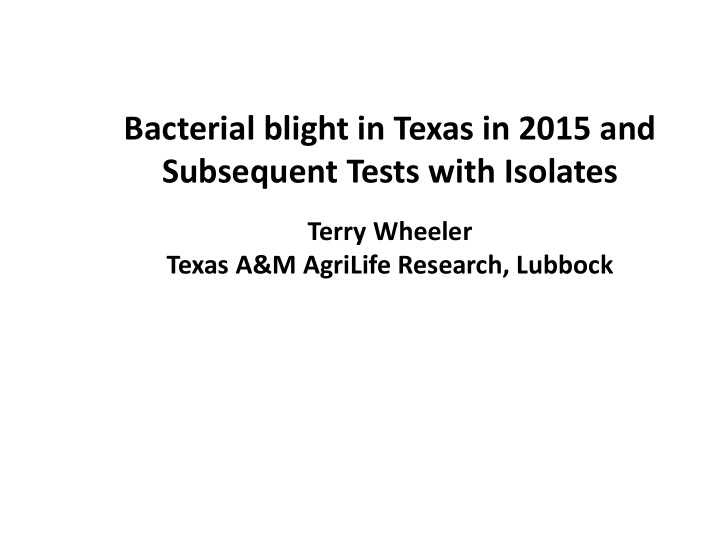



Bacterial blight in Texas in 2015 and Subsequent Tests with Isolates Terry Wheeler Texas A&M AgriLife Research, Lubbock
Field Protocol for Bacterial Blight Inoculations 1) Grow bacteria in Trypticase Soy Broth for 1 ½ days; 2) Add 1800 ml to 50 gal of water + 379 ml of Silwet. 3) Apply over the top of the plants at 50 gal/acre. Apply on younger leaves (2-leaf stage until mid-Aug); Works better with well-water rather than city water.
Blight Resistant Varieties to Race 18 All-Tex (AT) ConchoB2XF, AT Nitro-44 B2RF Croplan Genetics 3787B2RF Deltapine (DP) 1359B2RF, DP 1518B2XF (GT) Dyna-Gro (DG) 2615B2RF, DG 3445B2XF (GT), DG 3544B2XF (GT) Fibermax (FM) 1830GLT, FM 1900GLT, FM 1911GLT, FM 2007GLT, FM 2011GT, FM 2334GLT, FM 2484B2F, FM 8270GLB2, FM 9250GL NexGen (NG) 1572RF, NG 4111RF, NG 4012B2RF, NG 4545B2XF, NG 3500XF Phytogen (PHY) 243WRF, PHY 339WRF, PHY 575WRF Stoneville (ST) 5115GLT, ST 5289GLT, ST 6448GLB2.
Bacterial Blight at Plains
Incidence of blight at three dates (8/5, 8/26, and 9/16)
Relationship between Blight Incidence and Lint Yield (51% Incidence of Blight = 10% Predicted Yield loss)
List of Locations and Cultivars with Bacterial Blight in 2015 # iso. a Location Obtained from cultivars listed Amherst 6 FM 1830GLT (R) Dawson county 14 PHY 333WRF (S), DP 1219B2RF (S), ST 4946GLB2 (S) Helms farm 11 PHY 333W3FE (R), PHY 222W3FE (R?) Halfway-station 11 FM 1911GLT (R) , BX 1532GLT (S), Breeding line (?) ST 4747GLB2 (S) Hall co. 5 ST 4946GLB2 (S), PHY 499WRF (7) Lamesa- 13 AGCARES Garden City 23 BX 1630GLT(S), DP 1321B2RF (S), BX 1638GLT (S), FM 2322GL (S) Lubbock-E Loop 11 FM 2484B2F (R) Lubbock- 7 Breeding line (?) reniform test PHY 417WRF (S) Lubbock-Jones 2 DP 1219B2RF (S) Lubbock-Regis 7 Lubbock-Pima 3 Pima breeding lines (?) Plains 1 Unknown (S) Ropesville 7 BX 1633GLT (S), DP 1522B2XF (S) FM 958 (R ), PHY 333WRF (S) South Texas 2
Greenhouse testing of Isolates from some Locations on Varieties 100 Incidence of water soaking 80 60 40 20 0 Amherst Dawson Gcity HalfCom HalfDev Helms AGCARES Lubbock Ropes
• No consistent unusual response within a location or variety. • Unusual responses probably due to inconsistency within seed of a variety, or due to a mistake in placing the variety in a test. • These isolates do not behave like a new race that has defeated the resistant genes available.
Questions still to be understood 1) How did disease foci occur in resistant varieties in the field? 2) There was a second bacteria with a lot of ooze associated with Xanthomonas in isolations from Plains, Helms, and Quaker Farm . 3) Lack of pure yellow, mucoid colonies originally from South Texas; Ropes; Quaker Farm (Lubbock) and Plains. 4) Samples taken from Lubbock (Jason Woodward), Amherst (Mark Kelley), and Halfway were isolated without difficulty, even though they came from resistant varieties. 5) Samples taken from one location in South Texas (M isolates), Garden City, Lubbock (Regis and Casey Jones), Dawson co., AGCARES, came from susceptible varieties and were isolated without difficulty.
Recommend
More recommend